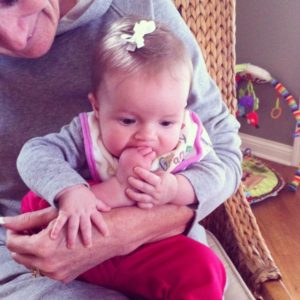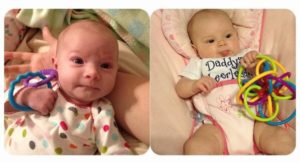Your baby’s gross motor development occurs along predictable Cephalo-Caudal principles. As a reminder, this means that your baby develops motor strength and muscle control starting from from the top (Cephalo, Latin for “Head”) toward the bottom (Caudal, Latin for “tail”). This principle of development means that first, your baby works on achieving head and neck control, then upper body strength in the arms, shoulders and upper torso, then lower abdominal strength, and finally, leg strengthening and balance for walking.
For this context, think of the first year of life for a human child as a timeline from birth, essentially laying flat with very little muscle control, to one year, when a baby is now upright, standing and moving independently (cruising, crawling or walking).
The mid-way point, six months, the baby is halfway there. During the sixth month, most babies will be working on sitting upright, and on finding some way to move. Here’s how tummy time plays a critical role in building strength for these skills. Tummy time doesn’t go away, it evolves into “Floor Time”.
Between 2 – 4 months, babies (hopefully!) are working on tummy time, beginning to push up on bent arms and support their head, neck and eventually shoulders and upper body (pushing their chest up off the floor to the nipple level, even) for increasingly longer periods of time. What the 2 month old found frustratingly hard work when placed on his tummy, the 4 month old effortlessly performs: remaining propped up on his bent arms for much longer periods of time.
At five months, he’s ready for a new challenge: rather than resting on his bent forearms during tummy time, he may push straight up on extended arms, getting almost all his chest off the floor down to his belly button. After doing this for a week or two, you’ll begin to see some fancy developments: he’ll start pivoting in a circle and then moving (creeping) backward. Using some combination of pushing off with his arms, typically these earliest movements will take your baby sideways and backwards. These fun efforts mean that your baby will creep backward until he’s halfway under the couch or coffee table. You’ll watch him get stuck many times over, often to your amusement.
To encourage him to pivot (which strengthens his upper body) yet to lower his frustration (Frustration Tolerance – another skill) place a few tempting toys around him in a circle. This way, when his efforts take him away from the object of interest in front of him (because early movements tend to take babies sideways and backwards!) there will be a new and rewarding item that catches his attention.
This activity is called “Floor Time”. Unlike Tummy Time, where you may have needed to use a prop, position your baby carefully, and a receiving blanket was all that was needed, Floor Time requires more space. Your baby needs some space to begin to explore how his body can move, and motivation to investigate his environment. Months before he can crawl and even though he may not yet be able to roll, he’ll still figure out ways to somehow scooch, creep, wiggle or otherwise inch and arch himself a few feet in one direction or another.
A clean area rug or foam matting makes a perfect surface for floor time. Blankets and quilts tend to get bunched up under your baby’s efforts to move. When possible, bare feet is best for sensory input and for traction. Watch those little toes flex and dig into the surface to get leverage to push off with!
By six to eight months, your baby will figure out some version of movement. Though it may not be what you think of as “crawling”, most babies in this age group have some way of getting a few feet away from where you left them. HOW they move matters less than having the motor strength to move, and the cognitive desire to explore. Some babies will use their arms to pivot and creep backward, others will “commando crawl”, using lots of effort with their upper body to drag themselves forward. Some will use an amusing combination of rolling, shimmying or scooting to get around!
Time to Baby Proof!

